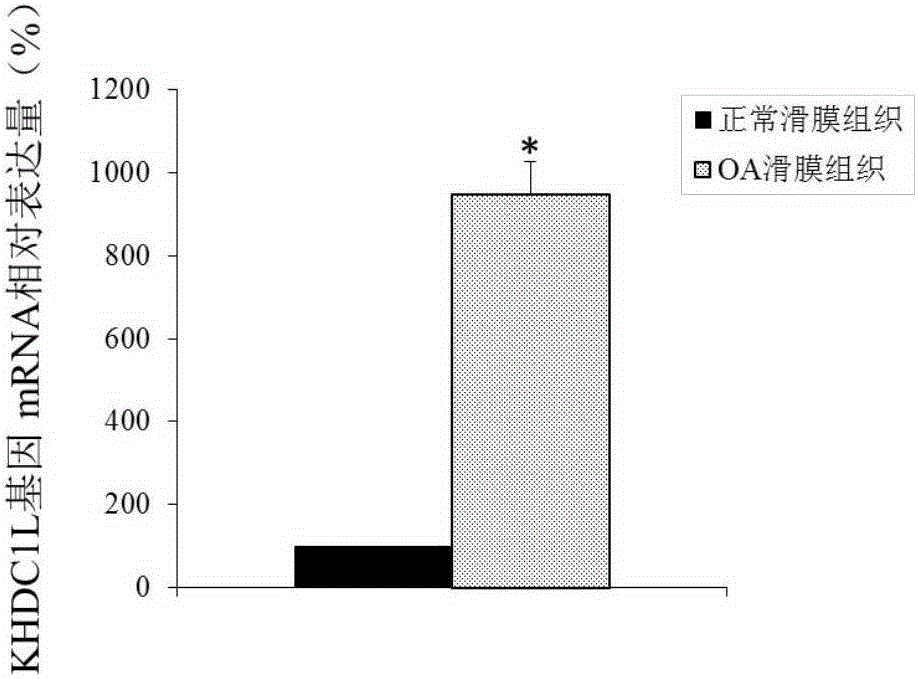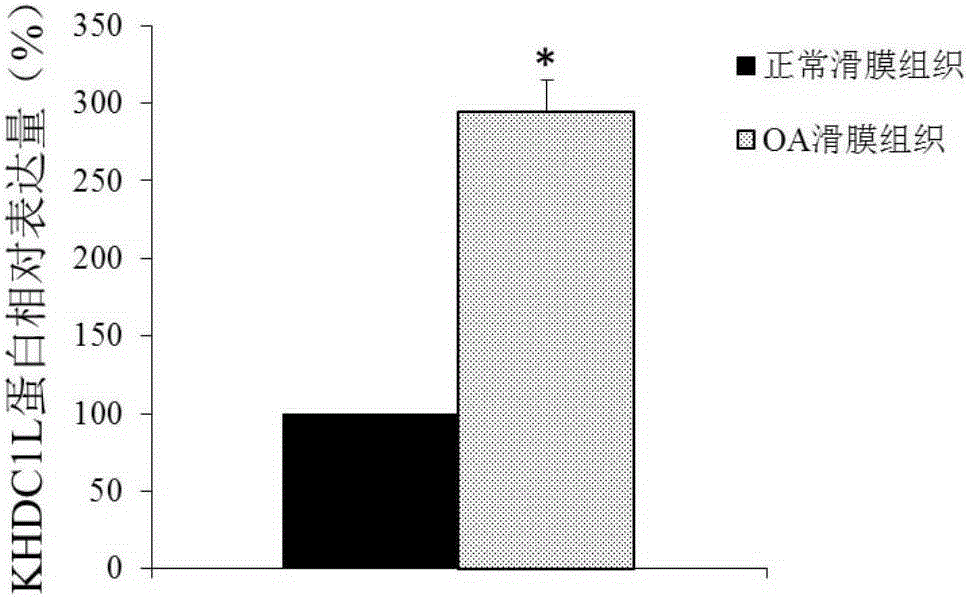Application of KHDC1L gene serving as disease diagnosis marker
A technology of gene and gene expression, applied in the field of diagnosis and treatment of osteoarthritis of human KHDC1L gene, can solve problems such as disability
- Summary
- Abstract
- Description
- Claims
- Application Information
AI Technical Summary
Problems solved by technology
Method used
Image
Examples
Embodiment 1
[0059] Differences in the expression of KHDC1L gene in embodiment 1OA synovial tissue and normal synovial tissue
[0060] The synovial tissues of 8 OA patients were obtained from OA patients undergoing knee arthroplasty or synovectomy in the Department of Orthopedics of Peking Union Medical College Hospital. The cases used were in line with the diagnostic criteria for OA proposed by Altam. 8 cases of normal synovial tissues were from the Department of Orthopedics, Peking Union Medical College Hospital, which were joint synovial tissues of patients undergoing trauma surgery. The synovial fluid (SF) of patients with OA was centrifuged at high speed, and the supernatant was collected and stored at -80°C until use. All clinical samples used in this study were informed to the patients and approved by the Ethics Committee of our hospital.
[0061] 1. Extraction of total RNA from synovial tissue
[0062] After collecting the samples, freeze them in liquid nitrogen. After taking th...
Embodiment 2
[0082] Example 2 Large sample verification of differentially expressed genes
[0083] The synovial tissues of 40 OA patients were obtained from OA patients undergoing knee replacement or synovectomy in the Department of Orthopedics of Peking Union Medical College Hospital. The cases used were in line with the diagnostic criteria for OA proposed by Altam. 40 cases of normal synovial tissues were obtained from the Department of Orthopedics of Peking Union Medical College Hospital, which were joint synovial tissues of patients undergoing trauma surgery. The synovial fluid (SF) of patients with OA was centrifuged at high speed, and the supernatant was collected and stored at -80°C until use. All clinical samples used in this study were informed to the patients and approved by the Ethics Committee of our hospital.
[0084] 1. Detection of differential expression of KHDC1L gene at the transcriptional level
[0085] 1.1 Extract synovial tissue total RNA
[0086] Step is with embo...
Embodiment 3
[0104] Example 3 OA fibroblast-like synoviocyte antibody neutralization experiment
[0105] 1. Steps
[0106] 1.1 In vitro culture of synovial tissue cells
[0107] After the aseptically obtained synovium tissue was washed with PBS, it was repeatedly cut into tissue pieces of about 1mmx1mmx1mm with sterile surgical scissors, added with collagenase II (0.5mg / ml) at 37°C, digested for 2 hours, passed through a 200-mesh gauze After filtration and centrifugation to remove the supernatant, the cells were resuspended in DMEM medium and placed at 37°C, 5% CO 2 Cultured in a cell culture incubator. After the cells grow into spindles and form sheets, they are subcultured. When the cells were passed to the third passage, FITC-labeled mouse anti-human CD3, CD14, CD19 and PE-labeled mouse anti-human CD11b were added for labeling, and flow cytometry was used for detection and identification. Cells negative for the above four markers were fibroblast-like synoviocytes (FLS) used in this ...
PUM
 Login to View More
Login to View More Abstract
Description
Claims
Application Information
 Login to View More
Login to View More - R&D
- Intellectual Property
- Life Sciences
- Materials
- Tech Scout
- Unparalleled Data Quality
- Higher Quality Content
- 60% Fewer Hallucinations
Browse by: Latest US Patents, China's latest patents, Technical Efficacy Thesaurus, Application Domain, Technology Topic, Popular Technical Reports.
© 2025 PatSnap. All rights reserved.Legal|Privacy policy|Modern Slavery Act Transparency Statement|Sitemap|About US| Contact US: help@patsnap.com



